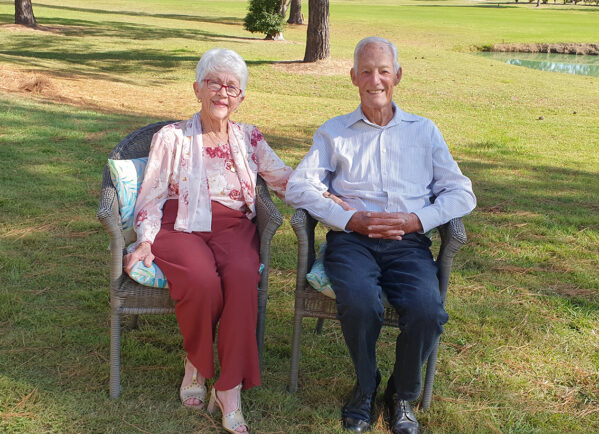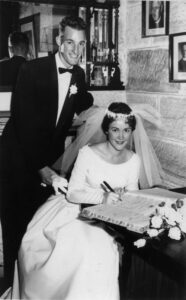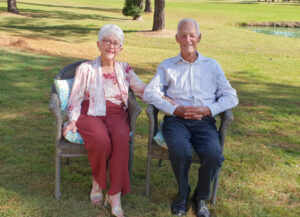Till death do us part: Reflections on 60 years of love and care
Till death do us part: Reflections on 60 years of love and care
by Sonja Kama
Monday, May 15, 2023
It was 1956 when Ron, 18, and Pam, 17 met. They married four years later, declaring their undying love for each other. They set out to build a long and happy life together, and to honour the wedding vows, ‘for better, for worse, for richer, for poorer, in sickness and in health, to love and to cherish, till death do us part’.

The couple spent much time early in their relationship making decisions about where and how they wanted to live. They raised three children, built two homes, ran their own businesses, and holidayed as a family and later travelled overseas together.
“My husband Ron was just an ordinary bloke who worked hard and gave a lot of time to his family – which included six grandchildren and one great grandchild – and his community," said Pam.
In 1994, at the age of 56, Ron suffered a heart attack and a few years later underwent a bypass surgery. In 2002 Ron recovered from a cardiac arrest. And while they still led a busy life, Ron’s health was never the same. The unexpected health challenges motivated Ron and Pam to create their Advanced Care Directives (ACD), so that their family would be aware of their last wishes.
"Decisions about where the best place is for loved ones to spend their last days, should be discussed openly and early," said Pam.
In their case, their ACD was kept at home, with copies kept with a GP and the local hospital.
Over time Ron faced various additional health problems, until eventually he needed more help.
“A lot of my time was caring for him, but this never seemed a burden to me. But not once did he say, ‘Why me’?” said Pam.
In 2020, Ron experienced another cardiac arrest.
“Immediately I dialled triple 0 as I had done so often. This time, with the help of the person on the line I performed CPR until the ambulance arrived,” said Pam. “And although he survived, he died six weeks later”.
 For Pam and her family, Ron’s final weeks and days of life did not play out how he had envisioned.
For Pam and her family, Ron’s final weeks and days of life did not play out how he had envisioned.
“His wish was to die at home, with his family by his side. Sadly, his final days were not all pleasant,” said Pam, explaining her disappointment that Ron’s wishes in his ACD plan had not been honoured.
“After being transferred from hospital to an aged care facility, Ron suffered from two falls within two weeks. Two days after his second fall he began to complain about the pain in his arm. By the fourth day the pain became intense, so I requested he be examined by his GP, who discovered he had a fracture to the upper arm,” said Pam.
Sadly, Ron died the following day.
“On the day he died, we were instructed by staff to leave Ron’s room. We followed their instructions and soon after we were called back only to find my husband had died or was seconds away. This distressed us greatly, as we were unable to say our last goodbyes to him while he was fully conscious. We like to think he knew we were with him at the end.”
The unfortunate experience of Ron dying without family being beside him, led Pam to reflect on the experience she and her family went through, through a short publication called ‘That Decision.’ Read the full story HERE.
In sharing their story, Pam aims to raise more awareness about the importance of creating and fulfilling end-of-life wishes and accessing quality palliative care.
“I hope that by writing our story and reflecting on our experience, more people can have their end-of-life wishes fulfilled.”
Pam’s reflections
- Don’t be rushed into making quick decisions about the respite or full-time care for a loved one. Instead, do thorough research first to ensure a facility is qualified and resourced to responsibly deliver the necessary palliative care needed.
- Contact the person’s GP and request that this is also done by the discharge doctor at the hospital.
- Before the person is admitted into care ask for an interview with the person at the facility who will admit your loved one and give a full list and history of their medical condition.
- After admission make certain that doctors’ and RN’s care and treatment instructions are carried out so that in the end you will have no regrets.
- Make sure the patient’s treatment and care are individualised and respected.
- If the person has a fall, request that a full examination is carried out by a qualified person.
- Always ask questions and challenge anything you are doubtful about.
- Instructions to the patient’s loved ones should be given with a full explanation as to why.
Thank you for sharing your story and learnings with us Pam and family, rest in peace Ron.
For advice, tools and support with 'matters of life and death' click HERE.

